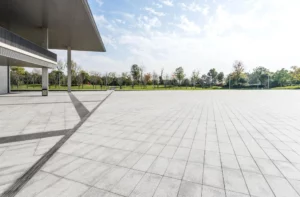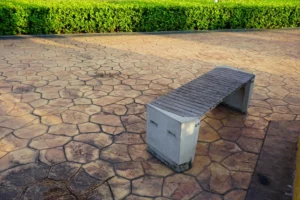Stamped concrete is a form of ornamental concrete patterned, textured, and agricultural concrete to resemble various other materials like stone, brick, slate, wood, and more. It is famous for outdoor surfaces such as patios, driveways, walkways, pool decks, indoor applications, and acetone concrete stain colors.
The process involves imprinting or “stamping” a pattern onto freshly poured concrete before it sets, creating the appearance of a different material while retaining the durability and cost-effectiveness of concrete.
Is stamped concrete slippery
Ever walked on a beautifully designed pathway and thought, “Wow, what material is this?” Chances are, you might have been admiring Stamped Concrete. Stamped Concrete, also known as imprinted, textured Concrete, or agricultural Concrete, imitates stones like slate and flagstone, as well as tile, brick, and even wood. It’s a budget-friendly and aesthetically pleasing material, but it leads us to an important question – Is stamped concrete slippery?
Before we dive deep into the slipperiness (or not) of stamped concrete, let’s first understand what it exactly is.
- Stamped concrete – It’s a type of decorative concrete that is patterned or “stamped” to resemble brick, slate, flagstone, stone, tile, and even wood.
- Slipperiness refers to how easily a surface allows an object (or a person) to slide across it due to low friction.
Finding the right balance between aesthetics and safety can be a bit of a tightrope walk. But don’t worry; we’re here to help you navigate this or all-star concrete mix. So, let’s embark on this quest to find out: Is stamped concrete slippery?
Stamped Concrete and How is it Made?
You might wonder what precisely stamped concrete is and how it is made? by concrete companies. Let’s delve deeper into this subject and unravel the mystery together.
Stamped concrete, often called imprinted or textured the concrete simulates materials such as slate, flagstone, tile, brick, and even wood. It’s famous for patios, pool decks, driveways, and interior floors. Not only does it offer aesthetic appeal, but it’s also a cost-effective and durable option.
The process of creating stamped concrete is intriguing. It involves a few steps to ensure the finished product has the desired look and feel.
- Mixing: The process starts with the mixing of concrete. The mixture includes cement, sand, aggregate, and water. The proportions are carefully calculated to achieve the desired strength and durability.
- Pouring: Next, the wet concrete is poured onto the surface that’s been prepared. The character could be a driveway, patio, or any other character that needs a touch of design and durability.
- Coloring: The concrete is then colored. It can be done by adding color hardeners or using an integral color added during mixing.
- Stamping: Finally, the concrete is stamped. The process involves pressing molds into the concrete while it’s still wet. The molds are made in the chosen design pattern, such as brick or stone.
Once the concrete has properly cured, which can take several days, it’s sealed for protection and longevity. The sealant also enhances the color and prevents it from fading over time.
Is Stamped Concrete Slippery?
One question that often comes up when considering stamped concrete is its slipperiness. This is particularly important if you’re thinking about using it in an outdoor area prone to getting wet, like a pool deck or a patio. The answer is yes and no. While the surface of stamped concrete can be slippery when wet, mainly if a high-gloss sealer has been applied, measures can be taken to increase its slip resistance.
Safety should always be your top priority, especially when designing outdoor spaces. With the proper planning and materials, stamped concrete can be a beautiful and safe choice for your home.
Ways to Make Stamped Concrete Less Slippery
With its beautiful patterns and designs, stamped concrete can be a stunning addition to any home. However, one concern often arises is its potential slipperiness, especially when wet. But don’t worry; several methods are available to make your stamped concrete less slippery and safer to walk on. Let’s dive into them.
Use a Non-Slip Additive
One popular solution to make stamped concrete less slippery is using non-slip additives. These additives are mixed into the sealer before it’s applied to the concrete. They come in various forms, like fine grit sand or clear plastic grit, and are designed to add texture to the concrete surface, reducing the chance of slipping.
Apply a Textured Sealer
Another option is to use a textured or anti-slip sealer and color para concreto. This type of sealer has a built-in texture, which gives the concrete surface a slightly rough feel, providing extra grip underfoot. However, it’s important to note that this option might slightly alter the aesthetic of your stamped concrete.
Maintain Regular Cleaning and Sealing
Maintaining stamped concrete through regular cleaning and sealing can also significantly reduce its slipperiness using concreta products. Cleaning removes the build-up of moss, algae, and other substances that can make the surface slippery while sealing protects the concrete and maintains its non-slip properties.
Install Traction Mats
If you want a quick and temporary solution, consider installing traction mats. These mats provide an instant grip and can be easily removed or replaced. They’reThey’re an excellent option for high-traffic areas or during specific seasons when the surface is more likely to become slippery.
Each of these methods can help make your stamped concrete less slippery, ensuring it’s beautiful and safe. Choose the one that best suits your needs and preferences.
How to Choose the Right Type of Concrete
Choosing the correct type of concrete for your needs can initially seem daunting, but don’t worry; I’m here to help you navigate this process though this concrete blog, and for others, you can visit our website or click here. It’s all about understanding your specific requirements and the characteristics of different concrete types.
Stamped concrete, for example, is a popular choice for many homeowners and commercial property owners. It’s aesthetically pleasing, durable, and can mimic the look of more expensive materials such as brick or stone. But one question often arises – is stamped concrete slippery?
Factors to Consider When Choosing Concrete
When deciding on the type of concrete to use, there are several factors to take into account:
- Durability: Some concrete types are more durable than others. Durability is critical if the concrete is subjected to substantial footfall or adverse weather circumstances.
- Maintenance: Different concrete types require different levels of care. Stamped concrete, for example, needs to be resealed every few years.
- Cost: The cost of the concrete and installation can vary widely. It’s important to balance cost with other factors like durability and maintenance.
- Aesthetics: The concrete’s look can significantly impact your property’s overall appearance. It provides an extensive array of patterns and colors.
To sum up, is stamped concrete slippery? It can be, but with the proper precautions and choice of sealer, it doesn’t have to be. Always consider your needs and safety when selecting the type of concrete for your project.
The Future of Stamped Concrete
Stamped concrete is not just a trend but also agricultural concrete and takes up space of cloudburst concrete; it’s here to stay. This revolutionary material quickly becomes the go-to choice for homeowners and businesses and has colourmix concrete. But what does the future hold for stamped concrete? Let’s look at the innovative design ideas paving the way forward.
Environmentally Friendly Options
As our society becomes increasingly aware of the need for sustainability, it’s no surprise that this focus is trickling down to construction materials like stamped concrete. Expect more environmentally friendly options on the market, made from recycled materials requiring less energy and combat concrete.
Increased Durability
While stamped concrete is already known for its durability, the future is likely to bring even more improvements. In addition, there might include new sealants and finishes that increase the lifespan of the concrete, reducing the need for maintenance and repairs.
Stamped concrete is more than just a stylish choice; it’s also practical and sustainable. With these exciting advancements on the horizon, it’s clear that the future of stamped concrete is brighter than ever.
The Popularity of Stamped Concrete in Home Design
You might’ve noticed that stamped concrete is becoming increasingly popular in home design. As the homeowner, you’re probably wondering why. Let’s delve deeper into this trend.
Firstly, stamped concrete is an excellent choice for those seeking a high-end look without the high-end price tag. It can mimic more expensive materials such as natural stone or brick, providing an upscale finish at a fraction of the cost. This versatility in design, coupled with its affordability, is a big attraction for many.
Secondly, its durability makes it a sound investment. Stamped concrete is resistant to weather, wear, and tear, making it ideal for outdoor spaces like patios and walkways. It’s also easy to maintain – a simple sweep or rinse with a hose is often all it takes to keep it looking its best. If you have any further question or if you want to get more knowledge then you should be visit here.
Frequently Asked Questions
Q1.What are some common materials that stamped concrete can replicate?
Ans. Stamped concrete can replicate materials like slate, flagstone, brick, tile, and wood.
Q2. What are the benefits of using stamped concrete in home design?
Ans. Stamped concrete is popular in home design due to its ability to mimic more expensive materials at a lower cost. It offers both aesthetic appeal and durability, making it an attractive choice for various outdoor and indoor spaces.
Q3. What factors should homeowners consider when choosing between different types of concrete for their projects?
Ans. When choosing between different types of concrete, factors to consider include durability, maintenance requirements, cost, and aesthetic preferences.
Q4. Can you explain the process of stamping concrete to create various patterns and designs?
Ans. Stamping concrete involves pressing molds into the wet concrete while it’s still pliable. These molds are designed to replicate various patterns and textures, such as brick or stone.
Q5. Can you elaborate on how technology, such as 3D printing, might impact the future of stamped concrete design?
Ans. Technology like 3D printing could allow homeowners to create intricate and unique patterns in stamped concrete, expanding the design possibilities.
